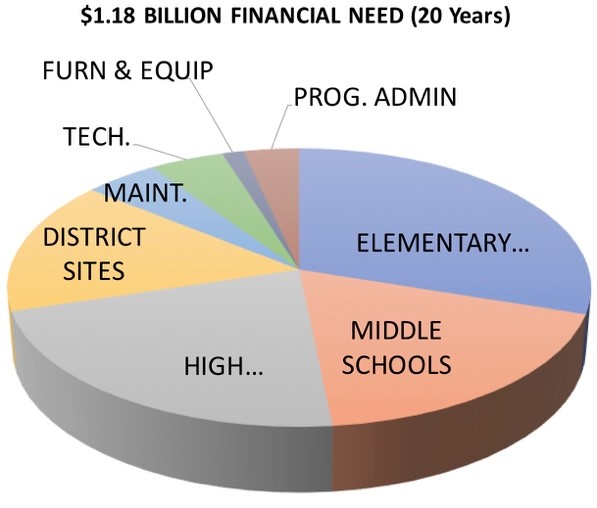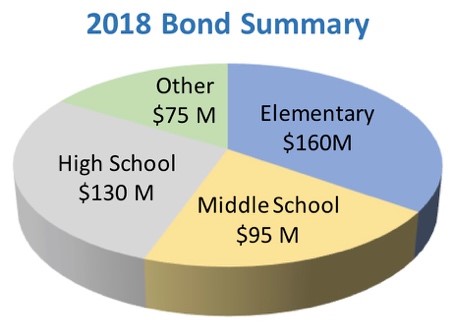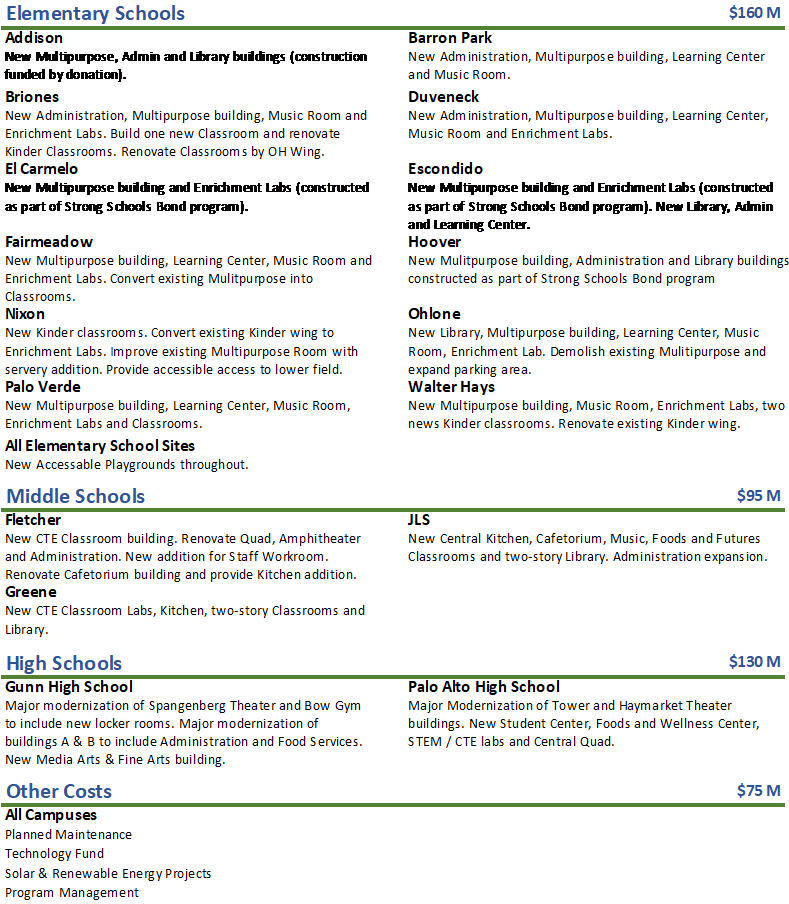The Palo Alto Unified School District has continued to improve its school facilities during the past two decades with the implementation of two bond programs; the Building for Excellence Program and the Strong Schools Bond program. Both bond programs focused on modernization or replacement of classroom facilities to modern day standards with respect to infrastructure, technology and aesthetics.
Nearing completion of the Strong Schools Bond program, the Board of Education approved a District Master Plan update in May 2017. Over the past year, the master planning team of fs3Hodges, HED Architects and Gelfand Partners Architects worked with District Leadership staff to develop new Educational Specifications for new facilities.
Using these Educational Specifications as a guide, the team met with each school site to identify campus specific needs and deficiencies and develop plans to implement the new Educational Specifications on each campus.
In May of 2018, staff completed master plans and presented proposed project lists for each campus that provided an assessment of the improvements made to district facilities the past 20 years and outlined the future needs of for the district for the next 20 years.
The future work required to keep Palo Alto Unified School District’s facilities updated and in good condition is planned to be accomplished in four separate components. The scope of what work included in each fund is summarized below, along with the projected financial needs over the next 20 years and what is proposed to be funded in the 2018 bond:

Capital Improvements
The Capital Improvements component will provide funding for Modernization and New Facilities projects outlined in this Facilities Master Plan. For the Elementary Schools, this includes new Multi-Purpose facilities that include space to seat the student population in an assembly configuration, as well as provide food service capabilities, restrooms and storage space. In addition, new enrichment labs will be added to each campus to accommodate Music, Science and Art rooms. And finally, Learning Centers and Resource Centers will be provided at each campus, so that children with special educational needs can be accommodated at their neighborhood school.
At the Middle Schools, the scope of work included will provide new classroom spaces for CTE and Performing Arts . Visual and Performing Arts spaces will be enlarged to accommodate larger class sizes and Career Technical Education classrooms will be updated to accommodate current needs for the curriculum the plan also includes improvements to the Athletic facilities, including the locker rooms and shower areas.
At Gunn High School, new classroom facilities will be provided for Media, Visual and Performing Arts programs. Modernization projects will include renovation of Spangenberg Theater and the Administration and Student Services wings, which will be re-oriented to accommodate the new campus entry built during the Strong Schools bond program. Improvements to Titan and Bow gymnasiums and the football stadium are also planned.
At Palo Alto High School, work will include modernization and preservation of the Tower and Haymarket Theater buildings. These buildings not been renovated recently, and do not meet the schools needs in many areas. Other projects at Palo Alto High School include replacement of the 900 Building with new CTE lab spaces and rebuilding the Student Services building to accommodate a new Wellness Center and Food Service facility.
The Central Facilities for the District include the District Office, the Corporation Yard located on the Palo Alto High School campus, the Greendell and Garland sites. These facilities did not receive any improvements during the last two bond programs. The Garland and Greendell sites will require a significant investment if they are needed to accommodate future growth.
Planned Maintenance
The Planned Maintenance component is a continuation of the last two bond programs to keep the existing facilities modernized maintained and replaced on reasonable maintenance schedule. This includes new interior finishes, roofing, furnace replacements, lighting replacements, exterior painting and other preventative maintenance for each campus.
Technology
The Technology component is proposed as a replacement vehicle for computers and networking equipment for each campus as well as district-wide system needs. In-wall infrastructure and cabling are included in Capital Improvements funding, since this will likely be installed in conjunction will other low voltage systems.
Furnishings and Equipment
The Furnishings and Equipment component will provide funding for new desks, tables, chairs, copiers, projectors and screens, blinds or other movable equipment items that are not fixed and considered part of Capital Improvements.

From this report, it is estimated that the financial needs for projects throughout the District is nearly $1.18 Billion in funds over the next 20 years. The District’s Facilities needs are broken down further below:
- The amount above includes $355M for Capital Improvement Projects at the Elementary Schools, $216M at the Middle Schools, and $258M at the High Schools, for a total of $829M.
- In addition to the above Capital Improvement Projects, estimates and allowances were included in the plan for Central Facilities and Surplus sites. This amount totaled $184M.
- Funding for a Planned Maintenance program over 20 years would be $55 Million.
- The Technology needs are $55 Million for the next 20 years. This replaces computers and servers throughout the District on a 4-year cycle.
- The Furnishings and Equipment fund is proposed to be $6 Million to provide new chairs, desks, LED displays, projectors and other equipment for new spaces at each campus.
- There is also $10M set aside for Zero-Net Energy projects and $41M for Program Administration Costs over the next 20 years.
The primary source of funding for the future improvements is planned to come from passage of voter-approved bond propositions. While there may be other sources of funds available to the District in the future, such as statewide measures, the only source of funds that can be relied upon with any certainty is a voter-approved bond. The District will have two options on proposing a bond measure for voter approval.
- The first option would require a 66 2/3% affirmative vote for passage of the bond measure. If approved, this option would allow the District to be less specific on the scope of work and priorities prior to performing the work. This was the funding vehicle used to fund the Building for Excellence Program.
- The second option is a Proposition 39 bond measure, which requires just a 55% voter approval. Since the passage of Proposition 39 in 2000, most school districts have opted to put forward bond measures under these requirements, primarily due to the lower voter approval requirement.
From the build out of the past two programs, staff has estimated that the District and the contracting community can comfortably perform up to $30 to 50 Million of new construction and modernization work per year. Factors that contribute to this determination include limitations on school site access, placing interim facilities on campuses, the number of bidders in the community and district resources to support the construction program.
Given these criteria, a $375M and $460 Million bond measure was polled by the District to proposed voters for the November 2018 election. Based on positive polling results that showed support in the District for either amount, the Board of Education approved a $460M bond measure be put on the ballot.
In the past, the Board of Education adopted Sustainable Energy Guidelines that incorporated California’s Collaborative for High Performance Schools (CHPS) criteria as a minimum standard for new construction. However, new California ‘Cal Green’ energy codes largely incorporated CHPS guidelines, ensuring that all new projects built during the Strong Schools bond program were following this Board policy.
However, there is also a new State of California that requires all new public facilities and 50% of existing public facilities shall comply with net- zero energy requirements by the year of 2030. To accomplish this, the focus of future improvements related to energy will toward renewable energy, since generating energy is a necessary path toward achieving net-zero. However, the District’s overall Net-Zero -Energy strategy will need to include conservation and replacement of existing systems as well.
In addition, water conservation efforts are included in these plans, given California’s recent drought concerns and the increasing demand for a limited resource.
In May 2018, a survey was sent out to the Principals and staff leadership involved in the Master Planning efforts at each school. The survey was general for the Elementary and Middle Schools and was site specific for the High Schools. The results of the survey were used to develop the Preliminary Bond Project List below, but further evaluation is needed for implementation.


The Palo Alto Unified School District is committed to providing educational facilities that are safe, accessible to all students and energy efficient. The designed spaces at PAUSD should also be architecturally innovative and compatible with its surrounding environment while being economic to construct, operate and maintain. In order to meet these goals, PAUSD has developed these resources to guide the Architectural team as follows:
- Facilities Master Plan: This document herein conceptually lays out the 20-year long term vision for each campus.
- Educational Specifications: Compliments the Facilities Master Plan by programmatically defining the areas of a typical school site by identifying program needs and adjacencies.
- The projects established in this Master Plan document are conceptual in nature and based on meetings with current leaders in the district. These are a starting point in steps toward developing actual projects at each campus.